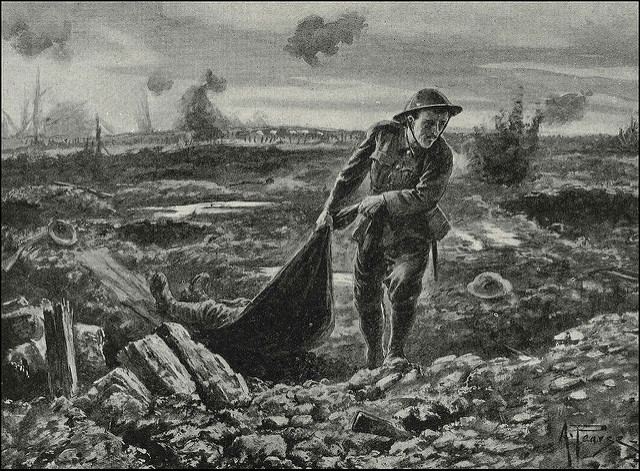Role Armed force officer Name Robert Quigg Rank Sergeant | Battles/wars World War I Years of service 1914 - 1926 Battles and wars World War I | |
 | ||
Similar People William McFadzean, Edmund De Wind, Douglas Haig - 1st Earl Haig, Fritz von Below, Ferdinand Foch | ||
Ww1 robert quigg
Robert Quigg VC (28 February 1885 – 14 May 1955) was a Northern Irish recipient of the Victoria Cross, the highest and most prestigious award for gallantry in the face of the enemy that can be awarded to British and Commonwealth forces. The award was made for his service at the Battle of the Somme in the First World War.
Contents

Youth

Robert Quigg was born on 28 February 1885 in the townland of Ardihannon in the parish of Billy, near the Giant's Causeway, County Antrim. His father, Robert Quigg senior, worked as a boatman and tour guide at the Giant's Causeway. Quigg attended the Giant's Causeway National School. Like most young teenage boys from the rural areas of the time, he left school and sought work on local farms. He worked for a number of years on Forsyth's farm at Turfahun and on the MacNaghten estate at Dunderave. Quigg was a prominent member of the local Orange Lodge Aird LOL 1195; he played in the flute band. He was also a member of the Royal Black Institution and the William Johnston Memorial RBP 559.
Ulster Volunteer Force
Quigg joined the Ulster Volunteer Force in January 1913, shortly after its formation and became commander of the Bushmills Volunteers. At that time, the UVF membership numbered over 100,000, with an estimated 40,000 bearing arms. In 1912, because of calls for Irish home rule, the Ulster crisis had deepened and Unionists perceived Ulster's constitutional position to be under threat. The Ulster Volunteer Force was formed to defend Ulster's position. At that time, the Ulster Volunteers were a legal force which had been empowered to carry out drilling and military preparations, with the proviso that it uphold the constitution.

As the European crisis, and war between Britain and Germany, became imminent, a halt was called to the Ulster Volunteer Force's preparations in Ulster. Sir Edward Carson, in turn, offered the services of the Ulster Volunteer Force to the United Kingdom government against Germany. The Ulster Volunteer members, who volunteered to join the British Army, formed the bulk of the 36th (Ulster) Division. Thousands of its members volunteered for active service; one such was Quigg. In September 1914, he enlisted in the 12th Battalion of the Royal Irish Rifles (Mid-Antrim Volunteers). His service number was 12/18645 and he held the rank of rifleman. His platoon officer was Sir Edward Harry Macnaghten, 6th Baronet, of the Macnaghten estate.
Battle of the Somme and Victoria Cross Award
Robert Quigg was awarded the Victoria Cross for "most conspicuous bravery" at the Battle of the Somme, 1 July 1916. Prior to the major offensive, his unit had been placed in the French village of Hamel, located on the north bank of the River Ancre. On 1 July, the Mid-Antrim Volunteers were ordered to advanced through the defences towards the heavily defended German lines. During the advance, they encountered fierce resistance from heavy machine-gun and shell fire. Quigg's platoon made three advances during the day, only to be beaten back on each occasion by German fire. The final evening assault left many hundreds of the 12th Battalion lying dead and wounded in "no man's land". In the early hours of the next morning, it was reported that Lieutenant Harry Macnaughten, the platoon commander was missing; Quigg volunteered to go out into "no man's land" to try to locate him. He went out seven times to search for the missing officer, without success. On each occasion, under machine gun fire, he managed to return with a wounded colleague. The last man he dragged in on a waterproof sheet from within a few yards of the enemy's wire. After seven hours of trying, exhaustion got the better of him; Quigg was so exhausted that he had to give up. The body of Lieutenant Macnaghten was never recovered and he is commemorated on the Thiepval Memorial.
On 8 January 1917, Quigg received his Victoria Cross from King George V, at York Cottage, Sandringham. Queen Mary was also in attendance. Upon his return to Bushmills, the people of the town and district turned out in force to welcome him home, including the Macnaghten household. Lady Macnaghten presented him with a gold watch in recognition of his bravery in attempting to find and rescue her son. Quigg reached the rank of sergeant before retiring from the army in 1926 (after he was badly injured in an accident). Later, in 1953, two years before he died, he met the newly crowned Queen Elizabeth II. Quigg died on 14 May 1955 at Ballycastle, County Antrim. He was buried in Billy Parish Churchyard, with full military honours. A stone tablet dedicated to his memory sits at the foot of the Bushmills war memorial. In June 2016 the Queen unveiled a statue of him in Bushmills.
The Russians also presented Quigg with the Medal of Order of St. George (Fourth Class), the highest award of the Russian Empire for non-senior officers. The First and Second classes were only given on the personal decree of the Emperor. The Third and Fourth classes were only awarded by the approval of the Georgevsky Council, a group of St George Knights. The Third Class was for senior officers, and the Fourth Class was the highest award of the Russian Empire for non-senior officers.
His Victoria Cross and Order of St. George (fourth class) are on display at the Royal Ulster Rifles Museum in the Cathedral Quarter, Belfast.
